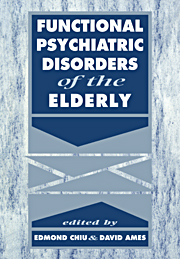Book contents
- Frontmatter
- Contents
- List of contributors
- Preface
- Introduction – A personal note
- Acknowledgement
- Part 1 Classification
- Part 2 General epidemiology
- Part 3 Neuroses
- Part 4 Affective disorders
- Part 5 Psychosexual disorders
- Part 6 Substance use and abuse
- Part 7 Schizophrenia and related psychoses
- Part 8 Psychological, biological and medical issues
- 20 A developmental psychology of old age
- 21 The biology of functional psychiatric disorders
- 22 Brain imaging in functional psychiatric disorders of the elderly
- 23 Medical co-morbidity: presentation in a general hospital setting
- 24 Psychiatric aspects of cerebro-vascular disease
- Part 9 Treatment methods
- Part 10 Conclusion
- Index
24 - Psychiatric aspects of cerebro-vascular disease
from Part 8 - Psychological, biological and medical issues
Published online by Cambridge University Press: 13 November 2009
- Frontmatter
- Contents
- List of contributors
- Preface
- Introduction – A personal note
- Acknowledgement
- Part 1 Classification
- Part 2 General epidemiology
- Part 3 Neuroses
- Part 4 Affective disorders
- Part 5 Psychosexual disorders
- Part 6 Substance use and abuse
- Part 7 Schizophrenia and related psychoses
- Part 8 Psychological, biological and medical issues
- 20 A developmental psychology of old age
- 21 The biology of functional psychiatric disorders
- 22 Brain imaging in functional psychiatric disorders of the elderly
- 23 Medical co-morbidity: presentation in a general hospital setting
- 24 Psychiatric aspects of cerebro-vascular disease
- Part 9 Treatment methods
- Part 10 Conclusion
- Index
Summary
Historical
Many of the early clinical masters in psychiatry and neurology recognized that depression was frequently associated with cerebro-vascular disease (Kraepelin, 1921; Bleuler, 1951). In spite of this early recognition that cerebro-vascular disease may lead to characteristic mood disturbances, there was by the 1940s a general acceptance of the idea that these mood disturbances represented a psychological response of the organism to severe stress (Starkstein & Robinson, 1989). Many more recent studies of depression after stroke, however, have consistently found that the severity of depression is not closely related to the severity of physical impairment, and it has increasingly been clear that the relationship between stroke and mood change is more complex than once thought. It was not until the late 1960s that systematic evaluation of mood changes in patients with brain injuries was undertaken, when different syndromes between left and right hemisphere lesions were found (Gainotti, 1972). Over the past decade research, mainly from Robinson and his coworkers in Baltimore, has focused on the possible relationship of various mood disorders to specific localization of the lesion in the brain.
Introduction
A number of good reviews of the psychiatric disorders after stroke have been published in the past five years (House, 1987a; Dupont, Callum & Jeste, 1988; Primeau, 1988; Starkstein & Robinson, 1989; Robinson & Starkstein, 1990; Johnson, 1991a). Apart from the obvious overlap in the two reviews of Robinson and Starkstein, each of these have approached the subject from a different perspective.
- Type
- Chapter
- Information
- Functional Psychiatric Disorders of the Elderly , pp. 407 - 424Publisher: Cambridge University PressPrint publication year: 1994
- 2
- Cited by



